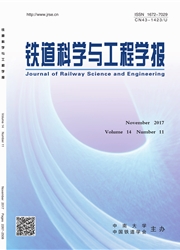

 中文摘要:
中文摘要:
为了将地铁瞬变压力的波动控制在人体舒适度范围内,根据三维不可压缩Navier-Stokes方程和标准k-ε紊流模型,以22.73 m2的地铁区间矩形隧道为研究对象,建立隧道-列车-空气数值模型,分析地铁隧道中列车特征部位压力和压力梯度的变化规律和影响因素。研究结果表明:列车运行速度超过100 km/h后,有必要在地铁入口处设置缓冲结构;缓冲结构降低压力最大值的效果并不显著,但降低压力梯度最大值的效果显著;喇叭型缓冲结构是优选的地铁入口降压措施;缓冲结构的最佳长度为2倍隧道水力直径;缓冲结构的横断面积越大,其降压效果越好;缓冲结构的最佳开孔率为30%左右。
 英文摘要:
英文摘要:
In order to control subway transient pressure's fluctuation within the evaluation standard of human comfort,the 22. 73 m2subway rectangular tunnel was investigated according to the three-dimensional incompressible Navier-Stokes equations and the standard k-ε turbulence model,and a tunnel-train-air simulation model was developed,by which a thorough study was conducted on change laws and influencing factors of pressure and pressure gradient on train body characteristic sections in subway. The results show that when the train's speed is larger than 100 km /h,it is necessary to build the buffer structure at subway inlet,and the buffer structure can reduce the maximum pressure gradient effectively,while its effect on lowering the maximum pressure is non-significant. The horn buffer structure is the optimization form of antihypertensive measures at the subway entrance,and the best length of buffer structure is 2 times the diameter of tunnel hydraulic diameter.Thereinto,the larger the cross sectional area of buffer structure,the better its antihypertensive effect. It can also be found from the research that the best open porosity of buffer structure is about 30%.
 同期刊论文项目
同期刊论文项目
 同项目期刊论文
同项目期刊论文
 期刊信息
期刊信息
